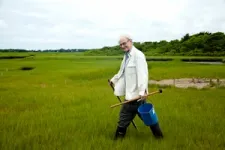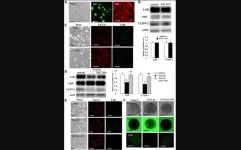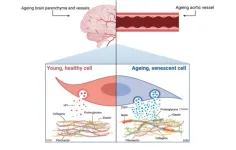(Press-News.org) LA JOLLA, CALIF. Mar 29, 2023 - Sanford Burnham Prebys researchers have identified a group of proteins that could be the secret to cellular reprogramming, an emerging approach in regenerative medicine in which scientists transform cells to repair damaged or injured body tissues. The researchers were able to reprogram damaged heart cells to repair heart injuries in mice following a heart attack. The findings, which appear in the journal Nature Communications, could one day transform the way we treat a variety of diseases, including cardiovascular disease, Parkinson’s and neuromuscular diseases.
“Even if a person survives a heart attack, there could still be long-term damage to the heart that increases the risk of heart problems down the line,” says lead author Alexandre Colas, Ph.D., an assistant professor in the Development, Aging and Regeneration Program at Sanford Burnham Prebys. “Helping the heart heal after injury is an important medical need in its own right, but these findings also pave the way for wider applications of cell reprogramming in medicine.”
Even though each of our cells has the same number of genes—approximately 20,000—cells can select which genes to “turn on” and “turn off” to change what they look like and what they do. This is the foundation of cellular reprogramming.
“Cellular reprogramming could, in theory, allow us to control the activity and appearance of any cell,” says Colas. “This concept has huge implications in terms of helping the body regenerate itself, but barriers to reprogramming mechanisms have prevented the science from moving from the lab to the clinic.”
The researchers identified a group of four proteins, named AJSZ, that help solve this problem.
“By blocking the activity of these proteins, we were able to reduce scarring on the heart and induce a 50% improvement in overall heart function in mice that have undergone a heart attack,” says Colas.
Although the researchers were primarily focused on heart cells, they determined that AJSZ is universal to all cell types. This suggests that targeting AJSZ could be a promising treatment approach for a variety of human diseases.
“This is helping us solve a very big problem that a lot of researchers are interested in,” says Colas. “Even more important, this breakthrough is a significant step forward on our way to turning these promising biological concepts into real treatments.”
The next steps in translating their discovery into a potential treatment is to explore different ways of blocking the function of the AJSZ proteins. According to Colas, the most promising option would be to use a small molecule drug to block the activity of AJSZ.
“We need to find a way to inhibit these proteins in a way we can control to make sure we are only reprogramming the cells that need it,” says Colas. “We will be screening for drugs that can help us inhibit these proteins in a controlled and selective manner in the coming months.”
###
Additional authors of the study include Maria A. Missinato, Michaela Lynott, Michael S. Yu, Anaïs Kervadec, Yu-Ling Chan, Christopher Lee, Prashila Amatya, Hiroshi Tanaka, Chun-Teng Huang, Pier Lorenzo Puri, Peter D. Adams and Alessandra Sacco, Sanford Burnham Prebys; Sean Murphy, Suraj Kannan, Chulan Kwon and Peter Andersen, Johns Hopkins University School of Medicine; and Li Qian, University of North Carolina at Chapel Hill.
The study was supported by grants from the California Institute of Regenerative Medicine (DISC2-10110), the National Institutes of Health (R01 HL153645, R01 HL148827, R01 HL149992, R01 AG071464), and Sanford Burnham Prebys institutional support to Alexandre Colas.
The study’s DOI is 10.1038/s41467-023-37256-8.
About Sanford Burnham Prebys
Sanford Burnham Prebys is an independent biomedical research institute dedicated to understanding human biology and disease and advancing scientific discoveries to profoundly impact human health. For more than 45 years, our research has produced breakthroughs in cancer, neuroscience, immunology and children’s diseases, and is anchored by our NCI-designated Cancer Center and advanced drug discovery capabilities. For more information, visit us at SBPdiscovery.org or on Facebook facebook.com/SBPdiscovery and on Twitter @SBPdiscovery.
END
Heart attack study could change the game in regenerative medicine
The breakthrough findings solve a known problem for scientists working on cellular reprogramming, one of the most promising areas of regenerative medicine
2023-03-29
ELSE PRESS RELEASES FROM THIS DATE:
Do your headaches happen at the same time of day?
2023-03-29
EMBARGOED FOR RELEASE UNTIL 4 P.M. ET, WEDNESDAY, MARCH 29, 2023
MINNEAPOLIS – Both cluster headache and migraine have strong links to the circadian system, the internal clock that regulates body processes, according to a meta-analysis published in the March 29, 2023, online issue of Neurology®, the medical journal of the American Academy of Neurology.
The meta-analysis included all available studies on cluster headache and migraine that included circadian features. This included information on the timing of headaches during ...
Imaging brain connections can predict improvements in obsessive-compulsive disorder patients after deep brain stimulation
2023-03-29
Deep brain stimulation (DBS) is a promising therapy for treatment-resistant obsessive-compulsive disorder (OCD). A first-of-its-kind collaborative study led by researchers at Texas Children’s Hospital, Baylor College of Medicine, and Brigham & Women’s Hospital has found that mapping neural connections in the brains of OCD patients offers key insights that explain the observed improvements in their clinical outcomes after DBS. The study was published in Biological Psychiatry.
Neuropsychiatric disorders such as obsessive-compulsive ...
Lab-made antibodies offer potential cure for yellow fever
2023-03-29
PORTLAND, Oregon -- New research from Oregon Health & Science University and collaborators indicates lab-made antibodies may be able to cure people infected with yellow fever, a virus for which there is no treatment.
The natural immune response to invading pathogens normally involves making protective proteins called antibodies. A study published today in Science Translational Medicine suggests that a single monoclonal antibody infusion can strengthen the body’s fight against yellow fever.
In the study, the yellow fever virus was undetectable in all animals that received monoclonal antibody infusions after being exposed to the virus.
“Two ...
Evermed, ACC launch ACC Anywhere, the 'Netflix of Cardiology'
2023-03-29
Evermed and the American College of Cardiology (ACC) have announced the launch of ACC Anywhere, a new content hub that provides cardiologists around the world with on-demand access to the latest clinical knowledge. The hub contains original content from five conferences including ACC’s 2022 and 2023 Annual Scientific Session, with additional conferences to be added in the future.
Evermed was selected to collaborate with ACC due to its advanced AI-powered recommender engine and its ability to effectively deliver medical education content 365 days per year. In addition, Evermed’s technology will help drive yearlong engagement to ensure that users are able ...
The clinical presentation of IDDMSSD syndrome is likely associated with the molecular location of the mutation in the PAK1 gene
2023-03-29
A recent study from Texas Children’s Hospital and Baylor College of Medicine has expanded the clinical spectrum of a new epileptic disorder called Intellectual Developmental Disorder with Macrocephaly, Seizures, and Speech Delay (IDDMSSD) with the identification of the first recurrently affected residue identified in the protein kinase domain of PAK1 protein. The study, published in the American Journal of Medical Genetics: Part A, found potential correlations between how and which organ ...
Downregulation of angulin-1/LSR induces malignancy in lung adenocarcinoma
2023-03-29
“In the present study, we found that downregulation of angulin-1/LSR induced malignancy via upregulation of EGF-dependent CLDN-2 and TGF-β-dependent cell metabolism in human lung adenocarcinoma.”
BUFFALO, NY- March 29, 2023 – A new research paper was published in Oncotarget's Volume 14 on March 24, 2023, entitled, “Downregulation of angulin-1/LSR induces malignancy via upregulation of EGF-dependent claudin-2 and TGF-β-dependent cell metabolism in human lung adenocarcinoma A549 cells.”
Abnormal expression of bicellular tight junction claudins, including ...
Bridging the Gap: addressing medical and social needs improves diabetes care and outcomes
2023-03-29
Nearly one in five American adults has diabetes. But that doesn’t mean the common condition is simple to treat or manage. Diabetes and its complications are the No. 1 cause of kidney failure, adult blindness, and lower-limb amputations. It’s also the seventh-leading cause of death in the U.S. As with so many chronic conditions, diabetes also disproportionately affects the most vulnerable in our communities, further exacerbating existing health disparities.
In a new supplemental issue of the ...
Research Brief: Study finds evidence of resistance to COVID-19 drugs
2023-03-29
(03/29/2023) — Resistance to Paxlovid is already evident among viral SARS-CoV-2 variants currently circulating globally, indicating that this stand-alone drug known as a protease inhibitor could soon become less effective in treating COVID-19 infections.
This conclusion was presented in a study published today online in the peer-reviewed journal Science Advances.
This study — conducted by the Midwest Antiviral Drug Discovery (AViDD) Center — shows that drug-resistant variants have appeared multiple times independently in different parts of the world, with regional clusters providing evidence for person-to-person transmission. In ...
Senescence and extracellular vesicles: novel partners in vascular amyloidosis
2023-03-29
“[...] there has been limited research to date on the effect of cellular ‘ageing’, termed senescence, on amyloidosis.”
BUFFALO, NY- March 29, 2023 – A new editorial paper was published in Aging (listed by MEDLINE/PubMed as "Aging (Albany NY)" and "Aging-US" by Web of Science) Volume 15, Issue 5, entitled, “Senescence and extracellular vesicles: novel partners in vascular amyloidosis.”
In their editorial, researchers Meredith Whitehead, Marco Antonazzi and Catherine M. Shanahan from King’s College London discussed amyloidosis—a ...
Excess death gap widens between US and Europe
2023-03-29
A new analysis shows that, compared to similarly high-income European countries, the US continues to have substantially higher death rates at all but the oldest ages, resulting in more “excess deaths,” and this gap widened during the Covid-19 pandemic. Patrick Heuveline, of the University of California, Los Angeles (UCLA), presents these findings in the open-access journal PLOS ONE on March 29, 2023.
Calculating excess death rates can be useful for comparing mortality between different countries or sub-populations, as well as before and after the onset of a health crisis. Prior research has documented a substantial widening of ...
LAST 30 PRESS RELEASES:
Duke and Duke-NUS’ joint cross-population research to uncover "East-West" differences in disease and care
Scientists to ‘spy’ on cancer- immune cell interactions using quantum technology breakthrough
Tech savvy users have most digital concerns
Making lighter work of calculating fluid and heat flow
Normalizing blood sugar can halve heart attack risk
Lowering blood sugar cuts heart attack risk in people with prediabetes
Study links genetic variants to risk of blinding eye disease in premature infants
Non-opioid ‘pain sponge’ therapy halts cartilage degeneration and relieves chronic pain
AI can pick up cultural values by mimicking how kids learn
China’s ecological redlines offer fast track to 30 x 30 global conservation goal
Invisible indoor threats: emerging household contaminants and their growing risks to human health
Adding antibody treatment to chemo boosts outcomes for children with rare cancer
Germline pathogenic variants among women without a history of breast cancer
Tanning beds triple melanoma risk, potentially causing broad DNA damage
Unique bond identified as key to viral infection speed
Indoor tanning makes youthful skin much older on a genetic level
Mouse model sheds new light on the causes and potential solutions to human GI problems linked to muscular dystrophy
The Journal of Nuclear Medicine ahead-of-print tip sheet: December 12, 2025
Smarter tools for peering into the microscopic world
Applications open for funding to conduct research in the Kinsey Institute archives
Global measure underestimates the severity of food insecurity
Child survivors of critical illness are missing out on timely follow up care
Risk-based vs annual breast cancer screening / the WISDOM randomized clinical trial
University of Toronto launches Electric Vehicle Innovation Ontario to accelerate advanced EV technologies and build Canada’s innovation advantage
Early relapse predicts poor outcomes in aggressive blood cancer
American College of Lifestyle Medicine applauds two CMS models aligned with lifestyle medicine practice and reimbursement
Clinical trial finds cannabis use not a barrier to quitting nicotine vaping
Supplemental nutrition assistance program policies and food insecurity
Switching immune cells to “night mode” could limit damage after a heart attack, study suggests
URI-based Global RIghts Project report spotlights continued troubling trends in worldwide inhumane treatment
[Press-News.org] Heart attack study could change the game in regenerative medicineThe breakthrough findings solve a known problem for scientists working on cellular reprogramming, one of the most promising areas of regenerative medicine





